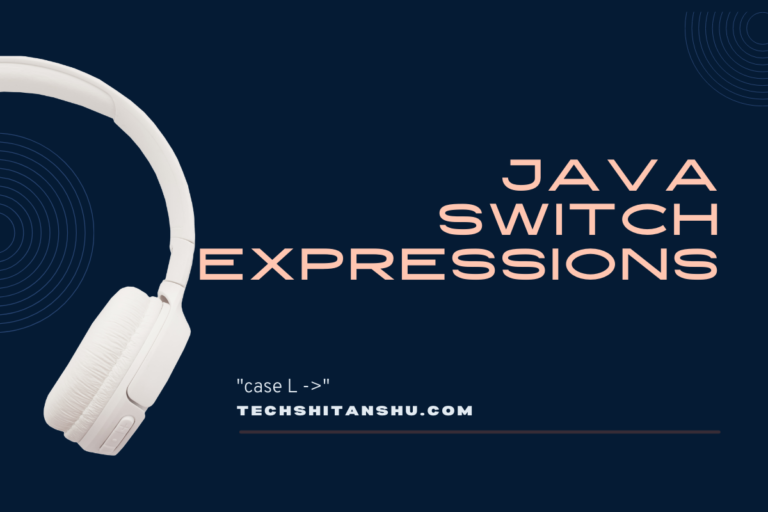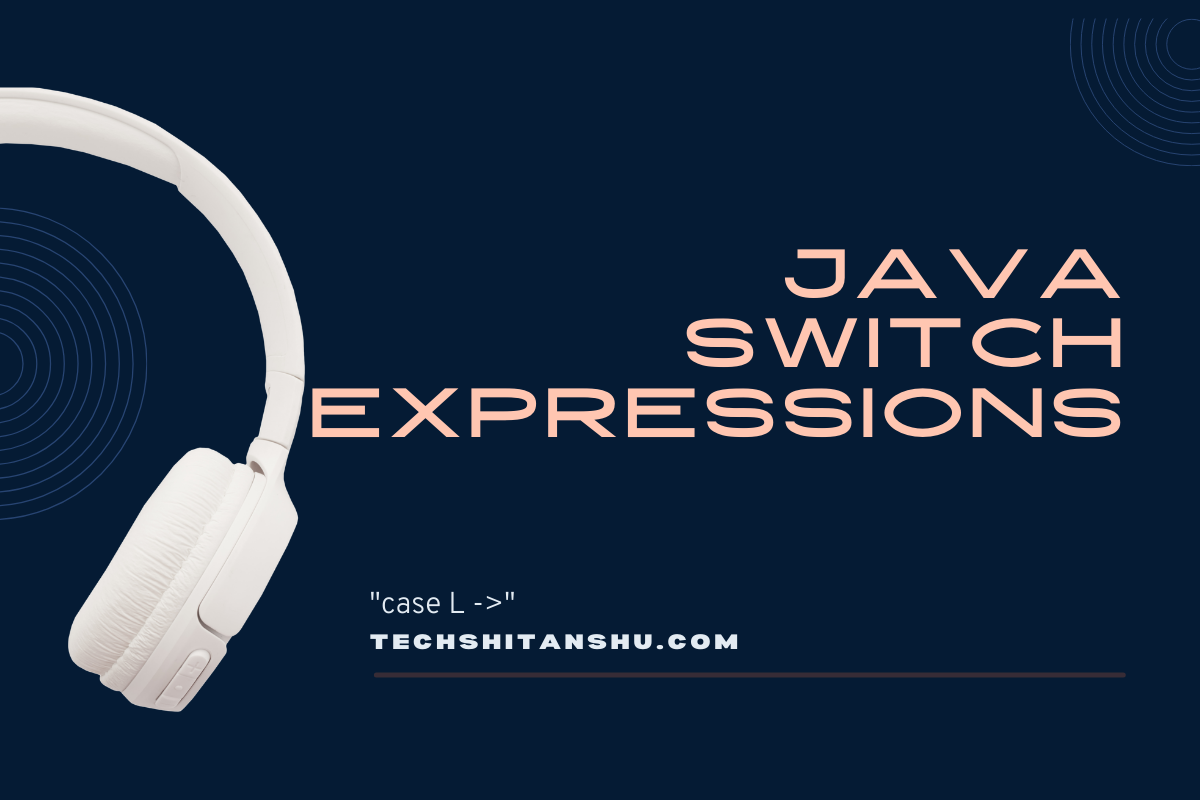Java Switch Expressions (Java 14+) – Complete Guide, Examples & Best Practices
Since Java 14 (standardized from preview), switch has evolved — you don’t just write statements anymore; you can now write switch expressions that return values. As a Java developer working on backend and cloud applications for over a decade, I’ve found switch expressions a game-changer for clean, readable, maintainable code.
In this guide we’ll cover:
What switch expressions are — and how they differ from old switch statements
Syntax & examples (basic → advanced)
Real-world use cases from my projects
Common pitfalls and how to avoid them
Performance & readability trade-offs
FAQs newborn to experienced devs ask

History
Java Switch Expressions were proposed in December 2017 by JEP 325. JEP 325 was targeted to JDK 12 in August 2018 as a preview feature. One aspect of JEP 325 was the overloading of the break statement to return a result value from a switch expression. Feedback on JDK 12 suggested that this use of break was confusing. In response to the feedback, JEP 354 was created as an evolution of JEP 325.
JEP 354 proposed a new statement, yield, and restored the original meaning of break. JEP 354 was targeted to JDK 13 in June 2019 as a java preview feature. Feedback on JDK 13 suggested that switch expressions were ready to become final and permanent in JDK 14 with no further changes.
What Are Switch Expressions in Java — And Why They Matter
Explain the concept, history, and motivation:
In older Java,
switchwas only a statement. Starting as a preview in Java 12/13 (JEP 325 / JEP 354) — now standard in Java 14+Difference: switch expressions return a value. They use new
case L ->syntax (arrow case) eliminating need forbreak, reducing fall-through bugs. Oracle Docsyieldkeyword allows returning values from code blocks inside switch expressions.
public enum Day { SUNDAY, MONDAY, TUESDAY,
WEDNESDAY, THURSDAY, FRIDAY, SATURDAY; }
// ...
int numLetters = 0;
Day day = Day.WEDNESDAY;
switch (day) {
case MONDAY:
case FRIDAY:
case SUNDAY:
numLetters = 6;
break;
case TUESDAY:
numLetters = 7;
break;
case THURSDAY:
case SATURDAY:
numLetters = 8;
break;
case WEDNESDAY:
numLetters = 9;
break;
default:
throw new IllegalStateException("Invalid day: " + day);
}
System.out.println(numLetters);
It would be better if you could “return” the length of the day’s name instead of storing it in the variable numLetters; you can do this with a switch expression in java. Furthermore, it would be better if you didn’t need break statements to prevent fall through; they are laborious to write and easy to forget. You can do this with a new kind of case label. The following is a switch expression that uses the new kind of case label to print the number of letters of a day of the week:
Day day = Day.WEDNESDAY;
System.out.println(
switch (day) {
case MONDAY, FRIDAY, SUNDAY -> 6;
case TUESDAY -> 7;
case THURSDAY, SATURDAY -> 8;
case WEDNESDAY -> 9;
default -> throw new IllegalStateException("Invalid day: " + day);
}
);
The new kind of case label has the following form:
case label_1, label_2, ..., label_n -> expression;|throw-statement;|block When the Java runtime matches any of the labels to the left of the arrow, it runs the code to the right of the arrow and does not fall through; it does not run any other code in the switch expression (or statement). If the code to the right of the arrow is an expression, then the value of that expression is the value of the switch expression.
You can use the new kind of case label in switch statements. The following is like the first example, except it uses “case L ->” labels instead of “case L:” labels:
int numLetters = 0;
Day day = Day.WEDNESDAY;
switch (day) {
case MONDAY, FRIDAY, SUNDAY -> numLetters = 6;
case TUESDAY -> numLetters = 7;
case THURSDAY, SATURDAY -> numLetters = 8;
case WEDNESDAY -> numLetters = 9;
default -> throw new IllegalStateException("Invalid day: " + day);
};
System.out.println(numLetters);
A “case L ->” label along with its code to its right is called a switch labeled rule in java.
Basic Syntax — Switch Statement vs Switch Expression
Provide side-by-side code examples:
// Old-style switch statement
int day = 3;
String dayName;
switch (day) {
case 1:
dayName = "Monday";
break;
case 2:
dayName = "Tuesday";
break;
case 3:
dayName = "Wednesday";
break;
default:
dayName = "Invalid day";
}
// Modern switch expression (Java 14+)
int day = 3;
String dayName = switch (day) {
case 1 -> "Monday";
case 2 -> "Tuesday";
case 3 -> "Wednesday";
default -> "Invalid day";
};
What Changed
| Old Switch | New Switch Expression |
|---|---|
case X: + break | case X -> no break needed |
| Assign value separately | Expression returns a value directly |
| More boilerplate, error-prone | Concise, less bug-prone |
Advanced Syntax & Features
String result = switch(dayOfWeek) {
case MONDAY, FRIDAY, SUNDAY -> "Weekend or Monday";
case TUESDAY, WEDNESDAY -> "Mid-week";
default -> "Other day";
};
Allows multiple constants per case label.
Using yield with Blocks
When you need multiple statements, side-effects, etc.:
int numLetters = switch (day) {
case WEDNESDAY -> {
System.out.println("Processing Wednesday");
yield "Wednesday".length();
}
default -> 0;
};
yield returns the value for the expression — similar to return, but inside switch.
Enums & Exhaustiveness Safety
With enums, switch expressions can enforce exhaustiveness: missing a constant can lead to compile errors.
This increases code safety compared to plain switch statements.
Real-World Use Cases from My Projects
Back when I worked on a microservices-based billing engine, we had to map HTTP request codes to internal status messages.
Using old switch statements: messy, easy to miss a
break, inconsistent fallback.Switching to switch expressions — code became clean, maintainable, and future-proof. I no longer needed multiple nested
if-elseor repeated assignments.
Other use cases:
Mapping enum status → user-friendly messages
Cleaner configuration-based branching
Reducing boilerplate in data transformation / DTO mapping
When to Use Java Switch Expressions — and When to Avoid
Good for:
Simple mapping from value → result (enums, primitives, strings)
Reducing boilerplate & avoiding fall-through bugs
Code readability and maintainability
Avoid when:
Logic is complex, needs many statements — use methods instead of overloading switch body
When value-based branching becomes too heavy — use polymorphism or strategy pattern
For operations needing side-effects, prefer explicit methods
Common Mistakes & Pitfalls
Trying to return from a switch expression without yield — results in compile error
Forgetting default case for non-enum switches — may lead to runtime exceptions
Overusing switch expressions for complex logic — reduces readability
Example Comparison — Before vs After Migration
Trying to return from a switch expression without yield — results in compile error
Forgetting default case for non-enum switches — may lead to runtime exceptions
Overusing switch expressions for complex logic — reduces readability
// Before
int result;
switch (value) {
case 1: result = 10; break;
case 2: result = 20; break;
default: result = -1;
}
return result;
// After
return switch (value) {
case 1 -> 10;
case 2 -> 20;
default -> -1;
};
FAQs (Java Switch Expressions)
Q: Which Java version supports switch expressions?
A: Switch expressions were introduced as a preview in Java 12/13, and became a standard feature in Java 14 with JEP-361.Q: Do I still need
breakwith new switch?
A: No. Withcase ... ->syntax,breakis not required — arrow syntax avoids fall-through by design.Q: Can I switch on enums, strings, or ints?
A: Yes — switch expressions support all types previously allowed in switch statements (primitives, boxed types, enums, strings).Q: What is
yieldused for?
A:yieldreturns a value from a code block inside a switch expression. Necessary when the block contains more than a single expression.Q: Is switch expression slower than method calls or if-else?
A: No significant overhead; performance is comparable — and readability/maintenance benefits usually outweigh any minor cost.
👉 Check out my guides on Java Lambda Expressions, Generics, and Pattern Matching.


Leave a Reply